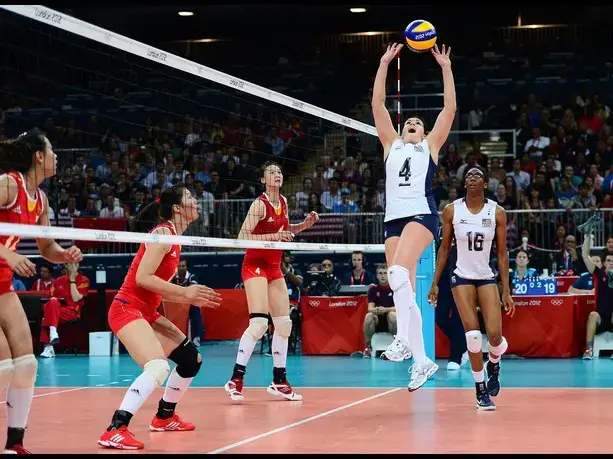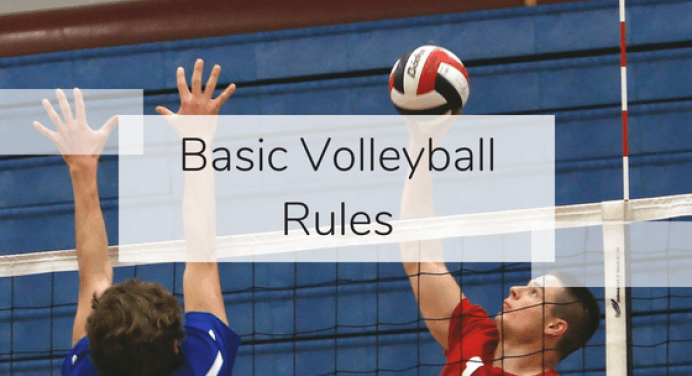Πόσα σετ στο βόλεϊ: Αποκαλύπτοντας το μυστήριο (2023)

Το βόλεϊ είναι ένα δυναμικό και συναρπαστικό άθλημα που απολαμβάνουν άνθρωποι όλων των ηλικιών. Μια κοινή ερώτηση που προκύπτει τόσο για τους νεοφερμένους όσο και για τους έμπειρους παίκτες είναι: “Πόσα σετ υπάρχουν στο βόλεϊ; Η κατανόηση της δομής των αγώνων και των σετ βόλεϊ είναι ζωτικής σημασίας για την πλήρη κατανόηση των μηχανισμών του παιχνιδιού. Σε αυτό το άρθρο, θα εμβαθύνουμε στις λεπτομέρειες σχετικά με το Πώς Πολλά σετ είναι στο βόλεϊ;
1. Εισαγωγή
Ανησυχείτε για το πόσα σετ στο βόλεϊ ; Τα σετ βόλεϊ είναι αναπόσπαστα συστατικά του παιχνιδιού, που καθορίζουν την έκβαση των αγώνων. Παίζουν σημαντικό ρόλο στη διαμόρφωση των στρατηγικών και της δυναμικής μεταξύ των ανταγωνιστικών ομάδων.
2. Κατανοήστε πόσα σετ στο βόλεϊ;
2.1 Τι είναι ένα σετ στο βόλεϊ;
Ένα σετ στο βόλεϊ αναφέρεται σε ένα ξεχωριστό τμήμα ενός αγώνα όπου και οι δύο ομάδες ανταγωνίζονται για να κερδίσουν 25 πόντους (σύστημα βαθμολογίας ράλι), με ελάχιστο προβάδισμα δύο πόντων για να κερδίσουν το σετ. Εάν ο αγώνας φτάσει στο πέμπτο σετ, ο στόχος πόντων συχνά μειώνεται στους 15.
2.2 Εξαρτήματα ενός σετ βόλεϊ
Κάθε σετ βόλεϊ αποτελείται από ράλι, τα οποία ξεκινούν από ένα σερβίς και ολοκληρώνονται όταν η μπάλα χτυπήσει στο πάτωμα ή βγει εκτός ορίων. Η ομάδα με το σερβίς εναλλάσσεται κάθε φορά που κερδίζει ένα ράλι.
2.3 Βαθμολογία σε σετ
Η βαθμολογία σημειώνεται σε κάθε ράλι, ανεξάρτητα από το ποια ομάδα εξυπηρετεί. Οι πόντοι κερδίζονται μέσω επιτυχημένων παιχνιδιών, όπως η προσγείωση της μπάλας στο γήπεδο του αντιπάλου ή η αξιοποίηση των λαθών του.
2.4 Διάρκεια ενός σετ
Το μήκος ενός σετ βόλεϊ μπορεί να ποικίλλει ανάλογα με παράγοντες όπως τα επίπεδα δεξιοτήτων και το στυλ παιχνιδιού των ομάδων. Κατά μέσο όρο, ένα σετ μπορεί να διαρκέσει 20 έως 30 λεπτά.
3. Αριθμός σετ σε διαφορετικούς αγώνες βόλεϊ

3.1 Αγώνες καλύτερους από τα τρία σετ
Σε πολλούς περιστασιακούς και μη επαγγελματικούς αγώνες, ακολουθείται η μορφή best-of-three set. Η ομάδα που κερδίσει δύο σετ στα τρία κερδίζει τον αγώνα.
3.2 Αγώνες καλύτερου από τα πέντε σετ
Οι επαγγελματικοί αγώνες και οι αγώνες υψηλού πονταρίσματος υιοθετούν συχνά τη μορφή best-of-5 σετ. Η πρώτη ομάδα που θα εξασφαλίσει τρία σετ στα πέντε βγαίνει νικήτρια.
Ο αριθμός των σετ σε έναν αγώνα βόλεϊ μπορεί να ποικίλλει ανάλογα με το επίπεδο του αγώνα. Σε γενικές γραμμές, οι επίσημοι αγώνες παίζονται με το best-of-5, που σημαίνει ότι η πρώτη ομάδα που θα κερδίσει τρία σετ κερδίζει τον αγώνα. Τα πρώτα 4 σετ παίζονται με 25 πόντους, με μια ομάδα να χρειάζεται να κερδίσει με τουλάχιστον 2 πόντους. Εάν το σκορ είναι ισόπαλο 24-24, το σετ συνεχίζεται έως ότου μια ομάδα έχει προβάδισμα 2 πόντων. Το πέμπτο σετ, ή το αποφασιστικό σετ, παίζεται στους 15 πόντους.
Ακολουθεί μια ανάλυση του αριθμού των σετ σε διαφορετικούς αγώνες βόλεϊ:
- Γυμνάσιο: 3 σετ, best-of-3
- Κολλέγιο: 5 σετ, best-of-5
- Επαγγελματικά: 5 σετ, best-of-5
- Ολυμπιακοί Αγώνες: 5 σετ, καλύτερο από 5
Υπάρχουν ορισμένες εξαιρέσεις σε αυτούς τους κανόνες. Για παράδειγμα, σε ορισμένα πρωταθλήματα νέων, οι αγώνες μπορεί να παίζονται με το καλύτερο από 3, με τα δύο πρώτα σετ να παίζονται με 21 πόντους. Επιπλέον, η FIVB (Διεθνής Ομοσπονδία Βόλεϊ) έχει έναν κανόνα που επιτρέπει ένα τάι μπρέικ 2 αγώνων στο τελικό σετ ενός αγώνα. Αυτό σημαίνει ότι εάν το σκορ είναι ισόπαλο 14-14, οι ομάδες θα κάνουν ένα διάλειμμα 2 λεπτών πριν παίξουν ένα νέο σετ 15 πόντων.
4. Αποφασιστικό σετ σε ισόπαλους αγώνες
Στο βόλεϊ, ένα αποφασιστικό σετ είναι ένα σετ που παίζεται για να καθοριστεί ο νικητής ενός αγώνα όταν το σκορ είναι ισόπαλο σε δύο σετ το καθένα. Το καθοριστικό σετ παίζεται στους 25 πόντους, ενώ απαιτείται πλεονέκτημα δύο πόντων για να κερδίσει το σετ. Εάν το σκορ είναι ισόπαλο 24-24, το παιχνίδι συνεχίζεται έως ότου μια ομάδα έχει προβάδισμα δύο πόντων.
Το αποφασιστικό σετ είναι συχνά το πιο συναρπαστικό μέρος ενός αγώνα βόλεϊ, καθώς και οι δύο ομάδες ταιριάζουν ισομερώς και το αποτέλεσμα είναι αβέβαιο. Η ομάδα που θα κερδίσει το καθοριστικό σετ είναι η νικήτρια του αγώνα.

Ακολουθούν οι κανόνες για το καθοριστικό σετ στο βόλεϊ:
Το καθοριστικό σετ μπορεί να είναι μια πολύ αγχωτική κατάσταση και για τις δύο ομάδες, καθώς το αποτέλεσμα του αγώνα καθορίζεται από ένα μόνο σετ. Για να κερδίσουν το καθοριστικό σετ, οι ομάδες πρέπει να είναι στρατηγικές και να επικεντρώνονται στα δυνατά τους παιχνίδια. Επιπλέον, οι ομάδες πρέπει να γνωρίζουν καλά τις στρατηγικές των αντιπάλων τους και να είναι έτοιμες να κάνουν γρήγορες προσαρμογές στο γήπεδο.
Ακολουθούν μερικές συμβουλές για να κερδίσετε το αποφασιστικό σετ στο βόλεϊ:
Το αποφασιστικό σετ είναι ένα κρίσιμο μέρος ενός αγώνα βόλεϊ. Ακολουθώντας αυτές τις συμβουλές, μπορείτε να αυξήσετε τις πιθανότητές σας να κερδίσετε το καθοριστικό σετ και τον αγώνα.
5. Στρατηγικές σετ βόλεϊ
Υπάρχουν πολλές διαφορετικές στρατηγικές σετ βόλεϊ που μπορούν να χρησιμοποιηθούν για τη δημιουργία ευκαιριών για την ομάδα σας. Εδώ είναι μερικά από τα πιο κοινά:
- Γρήγορα σετ: Τα γρήγορα σετ παραδίδονται στον παίκτη γρήγορα, προτού προλάβουν οι αποκλειστές να αντιδράσουν. Αυτά τα σετ χρησιμοποιούνται συχνά για τη ρύθμιση του μεσαίου μπλοκέρ για μια γρήγορη επίθεση.
- Αργά σετ: Τα αργά σετ παραδίδονται στον παίκτη πιο αργά, δίνοντας στους αποκλειστές χρόνο να αντιδράσουν. Αυτά τα σετ χρησιμοποιούνται συχνά για τη ρύθμιση του εξωτερικού χτυπητή για μια ισχυρή επίθεση.
- Νταμπ σετ: Τα σετ ανατρεπόμενων χτυπημάτων σκόπιμα στο έδαφος από την πλευρά του αντιπάλου του γηπέδου. Αυτά τα σετ χρησιμοποιούνται συχνά όταν ο σετ δεν μπορεί να στήσει έναν χτυπητή ή όταν η άμυνα περιμένει ένα σετ σε μια συγκεκριμένη τοποθεσία.
- Χ-σετ: Τα σετ Χ είναι σετ που παραδίδονται στον παίκτη πίσω από το σετ. Αυτά τα σετ χρησιμοποιούνται συχνά για να εκπλήξουν τους μπλοκέρ και να δημιουργήσουν ευκαιρίες για σκοράρισμα στον παίκτη που χτυπάει.
- Crossing σετ: Τα σετ διασταύρωσης είναι σετ που παραδίδονται στον παίκτη από την αντίθετη πλευρά του γηπέδου. Αυτά τα σετ χρησιμοποιούνται συχνά για να δημιουργήσουν ευκαιρίες για σκοράρισμα στον παίκτη και να κρατήσουν τους μπλοκέρ να μαντέψουν.
Η καλύτερη στρατηγική σετ βόλεϊ για χρήση θα εξαρτηθεί από τη συγκεκριμένη κατάσταση. Ο σκηνοθέτης θα πρέπει να λαμβάνει υπόψη τη θέση της πάσας, τη θέση των μπλοκέρ και τα δυνατά και τα αδύνατα σημεία των χτυπητών όταν παίρνει μια απόφαση.
Εκτός από τις συγκεκριμένες στρατηγικές σετ που αναφέρονται παραπάνω, υπάρχουν μερικές γενικές συμβουλές που πρέπει να έχουν υπόψη όλοι οι ρυθμιστές:
Ακολουθώντας αυτές τις συμβουλές, μπορείτε να γίνετε πιο αποτελεσματικός σετ και να βοηθήσετε την ομάδα σας να κερδίσει περισσότερους πόντους.
6. Επιρροή των σετ στον συνολικό αγώνα
Η επιρροή των σετ στο συνολικό αγώνα στο βόλεϊ είναι πολύπλοκη και εξαρτάται από διάφορους παράγοντες, όπως το επίπεδο του ανταγωνισμού, τις ομάδες που συμμετέχουν και τις συγκεκριμένες συνθήκες κάθε σετ. Ωστόσο, γενικά, υπάρχουν μερικοί βασικοί τρόποι με τους οποίους τα σετ μπορούν να επηρεάσουν το αποτέλεσμα ενός αγώνα.

Πρώτον, ο αριθμός των σετ που κέρδισε μια ομάδα μπορεί να είναι ένας καλός δείκτης της συνολικής της δύναμης. Μια ομάδα που κερδίζει περισσότερα σετ έχει περισσότερες πιθανότητες να κερδίσει τον αγώνα, ακόμα κι αν χάσει κάποια μεμονωμένα σετ. Αυτό οφείλεται στο γεγονός ότι για να κερδίσετε ένα σετ απαιτείται μια ομάδα να είναι σταθερά καλή σε όλες τις πτυχές του παιχνιδιού, από το σερβίς μέχρι το μπλοκ μέχρι την πάσα.
Δεύτερον, η ορμή που αποκτήθηκε ή χάθηκε σε ένα σετ μπορεί να μεταφερθεί στο επόμενο σετ. Μια ομάδα που κερδίζει ένα κοντινό σετ είναι πιθανό να έχει μεγαλύτερη αυτοπεποίθηση και κίνητρο στο επόμενο σετ, ενώ μια ομάδα που χάνει ένα κοντινό σετ είναι πιθανό να είναι πιο απογοητευμένη και απογοητευμένη. Αυτό μπορεί να έχει σημαντικό αντίκτυπο στην έκβαση του αγώνα.
Τρίτον, ο παράγοντας κόπωσης μπορεί επίσης να παίξει ρόλο στην επιρροή των σετ στο συνολικό αγώνα. Μια ομάδα που παίζει πολλά σετ στη σειρά είναι πιθανό να κουραστεί, κάτι που μπορεί να επηρεάσει την απόδοσή της. Αυτό ισχύει ιδιαίτερα για τους παίκτες που παίζουν στην πρώτη σειρά, οι οποίοι πρέπει να κάνουν πολλά άλματα και τρέξιμο. Μια κουρασμένη ομάδα είναι πιο πιθανό να κάνει λάθη, κάτι που μπορεί να δώσει στην άλλη ομάδα ένα πλεονέκτημα.
Συνολικά, η επιρροή των σετ στον συνολικό αγώνα στο βόλεϊ είναι πολύπλοκη και μπορεί να ποικίλλει ανάλογα με τις συγκεκριμένες περιστάσεις. Ωστόσο, οι παράγοντες που συζητήθηκαν παραπάνω είναι μερικοί από τους πιο σημαντικούς τρόπους με τους οποίους τα σετ μπορούν να επηρεάσουν το αποτέλεσμα ενός αγώνα.
Ακολουθούν ορισμένα πρόσθετα πράγματα που πρέπει να λάβετε υπόψη:
7. Παραλλαγές στους κανόνες συνόλου
7.1 Κανόνες σετ βόλεϊ εσωτερικού χώρου
Το βόλεϊ εσωτερικού χώρου ακολουθεί τυπικούς καθορισμένους κανόνες, με τις ομάδες να αγωνίζονται σε κλειστό χώρο σε ένα ορθογώνιο γήπεδο.
7.2 Κανόνες σετ μπιτς βόλεϊ
Το μπιτς βόλεϊ έχει τους δικούς του κανόνες που προσαρμόζονται στο υπαίθριο αμμώδες περιβάλλον, με παραλλαγές στο παιχνίδι και στο σκοράρισμα.
8. Συνήθη λάθη στα σετ μέτρησης
Είναι σημαντικό να παρακολουθείτε με ακρίβεια τα σετ κατά τη διάρκεια των αγώνων για να αποφύγετε τη σύγχυση και τις διαφωνίες.
Εδώ είναι τα συνηθισμένα λάθη στην καταμέτρηση σετ στο βόλεϊ, σε μορφή λίστας:
9. Συμπέρασμα
Η κατανόηση της δομής των αγώνων βόλεϊ και του αριθμού των σετ που εμπλέκονται ενισχύει την εκτίμησή σας για αυτό το δυναμικό και συναρπαστικό άθλημα. Είτε πρόκειται για την ένταση των αγώνων πέντε σετ είτε για τις στρατηγικές προσαρμογές που κάνουν οι ομάδες, κάθε πτυχή συμβάλλει στη γοητεία του βόλεϊ. Έτσι, την επόμενη φορά που θα παρακολουθήσετε έναν αγώνα βόλεϊ, θα κατανοήσετε βαθύτερα τη μορφή του παιχνιδιού και τον ενθουσιασμό που φέρνει. Αυτό το άρθρο περιγράφει πόσα σετ στο βόλεϊ;






